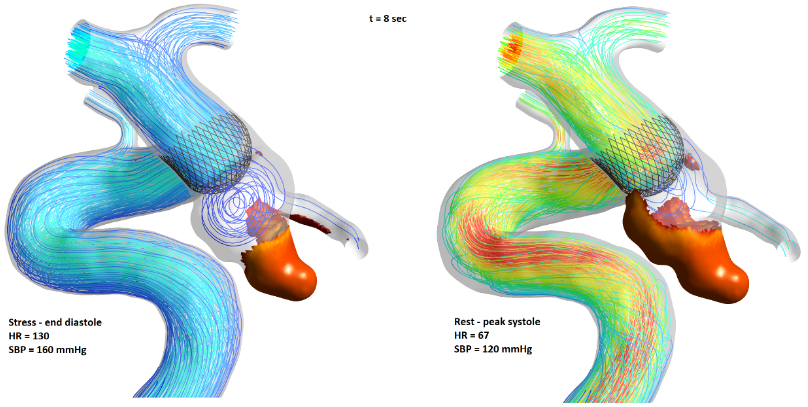Particle-based simulation and machine learning of thrombus formation models in brain circulation
- Academic lead
- Dr Toni Lassila, School of Computing, t.lassila@leeds.ac.uk
- Co-supervisor(s)
- Dr Amirul Khan, School of Civil Engineering, a.khan@leeds.ac.uk, Prof Tufail Patankar, School of Medicine and NHS Leeds Teaching Hospitals, tufail.patankar@nhs.net
- Project themes
- Biomedical Flows
A brain aneurysm is a life-threatening vascular distension of blood vessels. Common treatments for aneurysms involve a stent or a coil that aims to redirect blood flow away from the aneurysm. This triggers blood clotting and causes the aneurysm to heal and eliminates it from circulation. Computer simulations of the clot formation process can assist in the treatment-planning and design of new interventions for brain aneurysms.
Clot formation in human blood is complex, and its effects on brain aneurysms are still not fully understood. In this project, mathematical models for blood clotting will be coupled with three-dimensional blood flow models to make patient-specific predictions of how the clot will develop after the intervention and to predict its stability. The project will focus on: (i) modelling platelet cells as computational particles to better understand how they respond to shear stresses and (ii) acceleration of the computational simulations with physics-informed neural networks coupled with the particle-resolved flow field to make predictions of the final clot shape and its stability that are crucial in understanding when a particular treatment is likely to succeed.
 Figure 1: Virtual treatment planning model for flow diversion in cerebral, analysis of post-treatment clotting in two different flow scenarios (courtesy of Dr Ali Sarrami-Foroushani)
Figure 1: Virtual treatment planning model for flow diversion in cerebral, analysis of post-treatment clotting in two different flow scenarios (courtesy of Dr Ali Sarrami-Foroushani)
References:
- Seo JH, Eslami P, Caplan J, Tamargo RJ, Mittal R: A highly automated computational method for modeling of intracranial aneurysm hemodynamics, Frontiers in Physiology 9(681), 2018
- Peskin CS: The immersed boundary method, Acta Numerica 11:479-517, 2002.
- Lassila T, Manzoni A, Quarteroni A and Rozza G: Boundary control and shape optimization for the robust design of bypass anastomoses under uncertainty, ESAIM: Mathematical Modelling and Numerical Analysis 47(4):1107 - 1131, 2013
- Sarrami-Foroushani A, Lassila T, Hejazi SM, Nagaraja S, Bacon A, Frangi AF: A computational model for prediction of clot platelet content in flow-diverted intracranial aneurysms, Journal of Biomechanics 91:7-13, 2019.
- Quarteroni A, Lassila T, Rossi S and Ruiz-Baier R: Integrated Heart - Coupling multiscale and multiphysics models for the simulation of the cardiac function, Computer Methods in Applied Mechanics and Engineering 314:345-407, 2017
- Sarrami-Foroushani A, Lassila T, Gooya A, Geers AJ and Frangi AF: Uncertainty quantification of wall shear stress in intracranial aneurysms using a data-driven statistical model of systemic blood flow variability, Journal of Biomechanics 49(16):3815-3823, 2016
- Sarrami-Foroushani A, Lassila T, MacRaild M, Asquith J, Roes KC, Byrne JV, Frangi AF. In-silico trial of intracranial flow diverters replicates and expands insights from conventional clinical trials. Nature Communications. 2021 Jun 23;12(1):1-2.
- Khan MAI, Noakes CJ, Toropov VV: Development of a numerical optimisation approach to ventilation system design to control airborne contaminant dispersion and comfort, Building Simulation 5; 39, 2012
- Delbosc N, Khan MAI et al.: Real-time indoor air flow simulation using the lattice Boltzmann method on GPU. Computers & Mathematics with Applications 67:462, 2014
- Khan MAI, Delbosc N, Noakes CJ: Real-time flow simulation of indoor environments using lattice Boltzmann method, Building Simulation 8; 405, 2015
